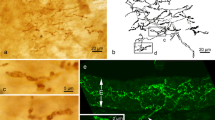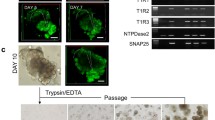Abstract
The distribution and development of growth-associated protein 43 (GAP-43)-like immunoreactivity (-LI) in the rat circumvallate papilla (CVP) were compared to those of protein gene product 9.5 (PGP 9.5)-LI. In the adult, thick GAP-43-like immunoreactive (-IR) structures gathered densely in the subgemmal region. Some of these further penetrated the apical epithelium and trench wall epithelium. At least two types of GAP-43-IR structures were recognized; taste bud-related and non-gustatory GAP-43-IR neural elements. Immunoelectron microscopy revealed that GAP-43-LI was localized predominantly in the Schwann cells, and a few axons displayed GAP-43-LI in the lamina propria. In the trench epithelium, GAP-43-LI was detected in the cytoplasmic side of the axonal membrane. Some intragemmal GAP-43-IR axons made synaptic-like contacts with taste bud cells. At least four developmental stages were defined on the basis of the changes in distribution of GAP-43-LI. In stage I [embryonic day (E) 16–17] GAP-43-IR structures accumulated at the lamina propria just beneath the newly-formed circumvallate papilla. In stage II (E18–19) GAP-43-IR nerve fibers began to penetrate the apical epithelium. In stage III [E20-postnatal day (P) 0] GAP-43-IR nerve fibers first appeared in the trench wall epithelium. Penetration of GAP-IR nerve fibers occurred in the inner trench wall epithelium first, and then in the outer trench wall epithelium. In stage IV (P1-) the distribution of GAP-43-LI was similar to that observed in the adult; but the density of GAP-43-LI was much higher than in adults. PGP 9.5-LI showed a similar distribution pattern to that of GAP-43-LI, except for round-shaped cells in the apical epithelium at the late embryonic stages, and in taste bud cells and intralingual ganglionic cells which lacked GAP-43-LI. The similarities in distribution patterns of GAP-43-LI and PGP 9.5-LI during the development and mature circumvallate papilla suggest that GAP-43 may be a key neuronal molecule for induction and maintenance of the taste buds.
Similar content being viewed by others
Author information
Authors and Affiliations
Additional information
Received: 20 May 1997 / Accepted: 11 March 1998
Rights and permissions
About this article
Cite this article
Wakisaka, S., Daikoku, H., Miyawaki, Y. et al. Immunohistochemical observation of growth-associated protein 43 (GAP-43) in the developing circumvallate papilla of the rat. Cell Tissue Res 293, 499–507 (1998). https://doi.org/10.1007/s004410051142
Issue Date:
DOI: https://doi.org/10.1007/s004410051142




